Related Research Articles
Cornish is the adjective and demonym associated with Cornwall, the most southwesterly part of the United Kingdom. It may refer to:

The red-billed chough, Cornish chough or simply chough, is a bird in the crow family, one of only two species in the genus Pyrrhocorax. Its eight subspecies breed on mountains and coastal cliffs from the western coasts of Ireland and Britain east through southern Europe and North Africa to Central Asia, India and China.

The Alpine chough or yellow-billed chough is a bird in the crow family, one of only two species in the genus Pyrrhocorax. Its two subspecies breed in high mountains from Spain eastwards through southern Europe and North Africa to Central Asia and Nepal, and it may nest at a higher altitude than any other bird. The eggs have adaptations to the thin atmosphere that improve oxygen take-up and reduce water loss.

The white-winged chough is one of only two surviving members of the Australian mud-nest builders family, Corcoracidae, and is the only member of the genus Corcorax. It is native to southern and eastern Australia and is an example of convergent evolution as it is only distantly related to the European choughs that it closely resembles in shape, and for which it was named.

There are two species of passerine birds commonly called chough that constitute the genus Pyrrhocorax of the Corvidae (crow) family of birds. These are the red-billed chough, and the Alpine chough. The white-winged chough of Australia, despite its name, is not a true chough but rather a member of the family Corcoracidae and only distantly related.
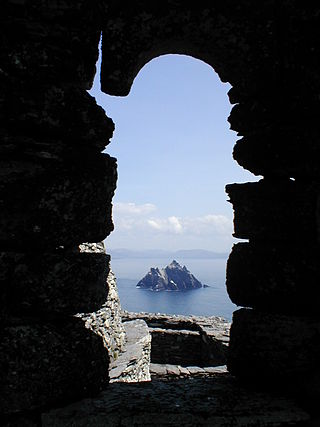
The Skellig Islands, once known as "the Skellocks", are two small, steep, and rocky islands lying about 13 km (8 mi) west of Bolus Head on the Iveragh Peninsula in County Kerry, Ireland. The larger of the two is Skellig Michael which, together with Little Skellig, is at the centre of a 364-hectare (899-acre) Important Bird Area established by BirdWatch Ireland in 2000. Skellig Michael is also famous for an early Christian monastery that is a UNESCO World Heritage Site.

The culture of Cornwall forms part of the culture of the United Kingdom, but has distinct customs, traditions and peculiarities. Cornwall has many strong local traditions. After many years of decline, Cornish culture has undergone a strong revival, and many groups exist to promote Cornwall's culture and language today.

Gwennap Head is a headland on the south coast of the Penwith peninsula, Cornwall, United Kingdom. It is within the parish of St Levan and approximately 4 miles (6.4 km) south of Land's End, and less than 1 mile (1.6 km) north-west of Porthgwarra, the nearest village. The area of Gwennap Head is designated as part of the Penwith Heritage Coast and also designated as part of the Cornwall Area of Outstanding Natural Beauty. The South West Coast Path closely follows the coastline around the headland.
Chuff may refer to:

Communal roosting is an animal behavior where a group of individuals, typically of the same species, congregate in an area for a few hours based on an external signal and will return to the same site with the reappearance of the signal. Environmental signals are often responsible for this grouping, including nightfall, high tide, or rainfall. The distinction between communal roosting and cooperative breeding is the absence of chicks in communal roosts. While communal roosting is generally observed in birds, the behavior has also been seen in bats, primates, and insects. The size of these roosts can measure in the thousands to millions of individuals, especially among avian species.
Treffry is a Cornish surname. The first record of the name Treffry is found in Cornwall, where they lived at Treffry near Lanhydrock. A Roger Treffry was born about 1260 and his descendant John Treffry was living in 1658.
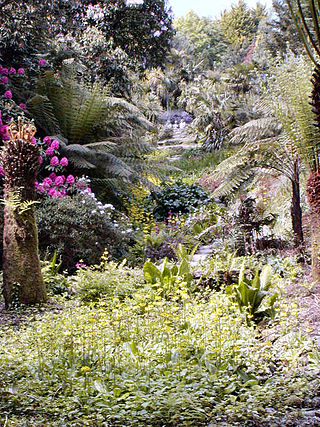
Cornwall is the county that forms the tip of the southwestern peninsula of England; this area has a mild and warm climate regulated by the Gulf Stream. The mild climate allows rich plant cover, such as palm trees in the far south and west of the county and in the Isles of Scilly, due to sub-tropical conditions in the summer.
Cornish heraldry is the form of coats of arms and other heraldic bearings and insignia used in Cornwall, United Kingdom. While similar to English, Scottish and Welsh heraldry, Cornish heraldry has its own distinctive features. Cornish heraldry typically makes use of the tinctures sable (black) and or (gold), and also uses certain creatures like Cornish choughs. It also uses the Cornish language extensively for mottoes and canting arms.
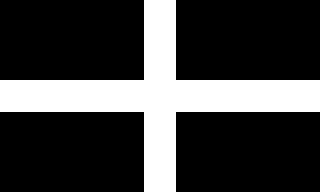
Many different symbols are associated with Cornwall, a region which has disputed constitutional status within the United Kingdom . Saint Piran's Flag, a white cross on a black background is often seen in Cornwall. The Duchy of Cornwall shield of 15 gold bezants on a black field is also used. Because of these two symbols black, white and gold are considered colours symbolic of Cornwall.
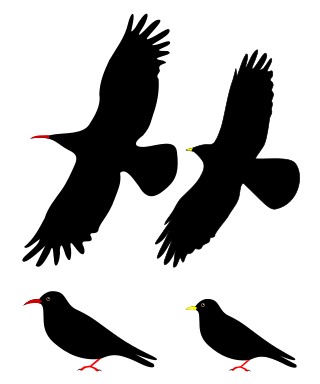
The birds of Cornwall are in general a selection of those found in the whole of the British Isles, though Cornwall's position at the extreme south-west of Great Britain results in many occasional migrants. The nightingale is one English bird which is virtually absent from Cornwall.

Paradise Park is a wildlife sanctuary situated in Hayle, Cornwall, England. It has over 1000 birds and animals and is the home of the World Parrot Trust.
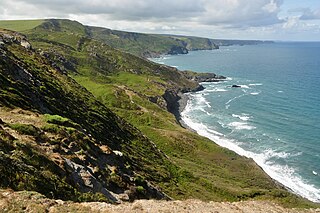
Boscastle to Widemouth is a coastal Site of Special Scientific Interest (SSSI) in Cornwall, England, noted for its biological and geological characteristics. The Dizzard dwarf oak woodland is unique and of international importance for its lichen communities, with 131 species recorded.
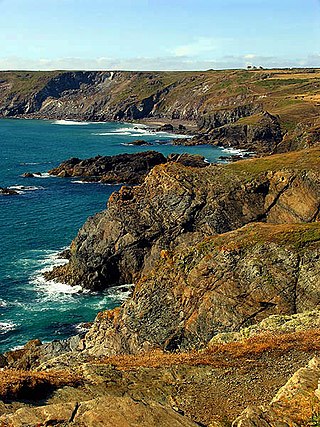
Caerthillian to Kennack is a coastal Site of Special Scientific Interest (SSSI) on the Lizard Peninsula in Cornwall, UK, noted for both its biological and geological characteristics. It is of great botanical importance, with several Red Data Book of rare and endangered plant species being found on the site, as well as a breeding site for Cornish choughs.

Porthgwarra to Pordenack Point is a coastal Site of Special Scientific Interest (SSSI) in west Cornwall, England, noted for its biological characteristics. The South West Coast Path runs through the SSSI.

Zennor Head is a 750-metre (2,460 ft) long promontory on the Cornish coast of England, between Pendour Cove and Porthzennor Cove. Facing the Atlantic Ocean, it lies 1 kilometre north-west of the village of Zennor and 1.6 kilometres east of the next promontory, Gurnard's Head. The granite (Killas) cliffs rise over 200 feet (60 m) from the sea and the highest point of the headland is 314 feet (96 m) above sea level, with an Ordnance Survey triangulation station. Zennor Head is on the South West Coast Path, which follows the cliff edge closely, skirting the entire perimeter of the headland. The promontory is part of the Penwith Heritage Coast, and is the largest coastal feature in the United Kingdom that begins with the letter "Z". It gets its name from a local saint, Senara. Zennor Head was mined for copper and tin in the Victorian Era. There is no longer any residential or commercial occupancy on the headland, but it is occupied by a variety of coastal animals and plants, such as kestrels and gorse.
References
- ↑ "Operation Chough". Paradise Park Wildlife Sanctuary. Retrieved 12 August 2016.
- ↑ "Research Papers". Operation Chough. 5 November 2015. Retrieved 30 June 2017.